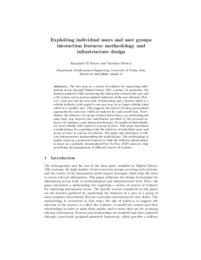Exploiting individual users and user groups interaction features: methodology and infrastructure design
Abstract
The user may be a source of evidence for supporting infor-
mation access through Digital Library (DL) systems. In particular, the
features gathered while monitoring the interaction between the user and
a DL system can be used as implicit indicators of the user interests. How-
ever, each user has his own style of interaction and a feature which is a
reliable indicator with regard to one user may be no longer reliable when
referred to another user. This suggests the need to develop personalized
approaches for each user which are tailored for each search task. Never-
theless, the behavior of a group of interrelated users, e.g. performing the
same task, may improve the contribution provided by the personal be-
havior; for instance, some interaction features, if considered individually,
are more reliable with regard to a group of users. This paper introduces
a methodology for exploiting both the behavior of individual users and
group of users as sources of evidence. The paper also introduces a soft-
ware infrastructure implementing the methodology. The methodology is
mainly based on a geometric framework while the software infrastructure
is based on a partially decentralized Peer-To-Peer (P2P) network, thus
permitting the management of di erent sources of evidence.
